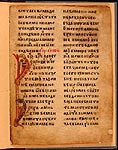Tetraevangelion.
Second half of 13th cent. Serbian version (Bosnian type). Fragment
F (270/276 ű 195/205). 6 leaves.
Parchment. Ink, colours, cinnabar.
It is written in a Bosnian uncial script in two columns. Spellings is typical for manuscripts of Bosnian origin.
The decoration of the manuscript contains large initials in ink, cinnabar, yellow and green paints with teratological motifs (fols. 1r, 5r, 6r). Headings and individual letters throughout the text are written in cinnabar.
The codex survives only in small fragments. In addition to 6 leaves from the holdings of National Library of Russia, another 2 leaves from this book are known - they are kept in the Russian State Library (Shelfmark: √ūŤ„. 11.I). The manuscript characterizes the provincial Slavic handwritten tradition. The Gospel was copied onto poorly prepared dark and rough parchment. A typical Bosnian uncial script creates an impression of some carelessness. Initials are drawn and painted with varying thoroughness.
Alexander Hilferding found the Gospel in 1857, while serving as a consul of Russia in Bosnia and Herzegovina. The place of discovery is unknown.
In 1868 the manuscript came into the Imperial Public Library along with the Alexander Hilferding's collection.
Shelfmark: –ÕŃ. √ŤŽŁŰ. 61.





